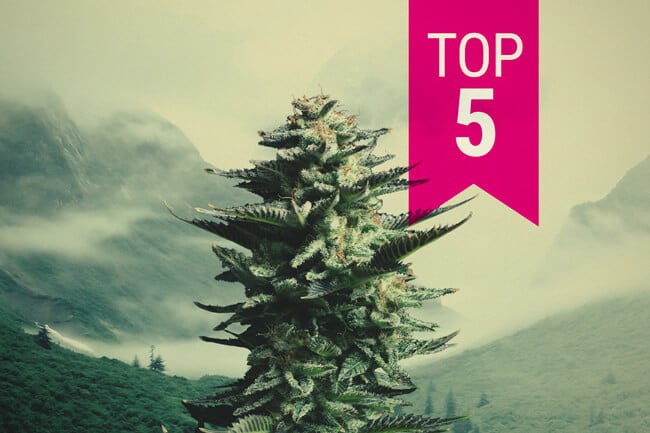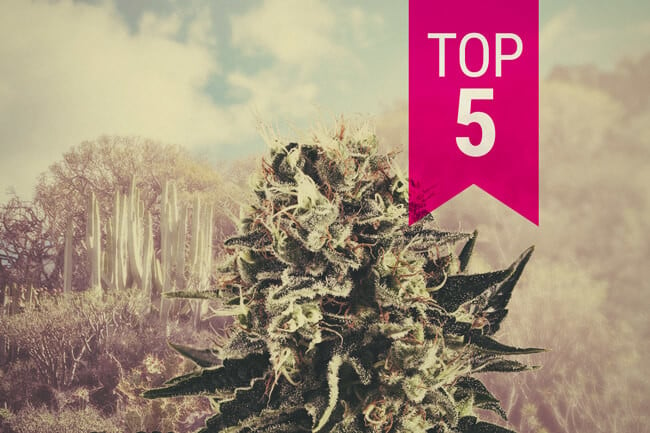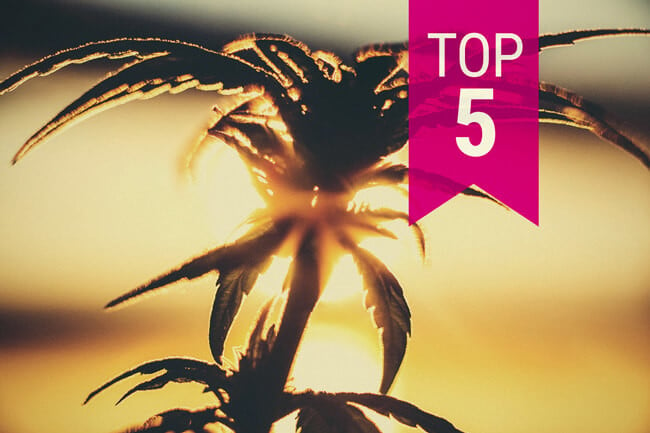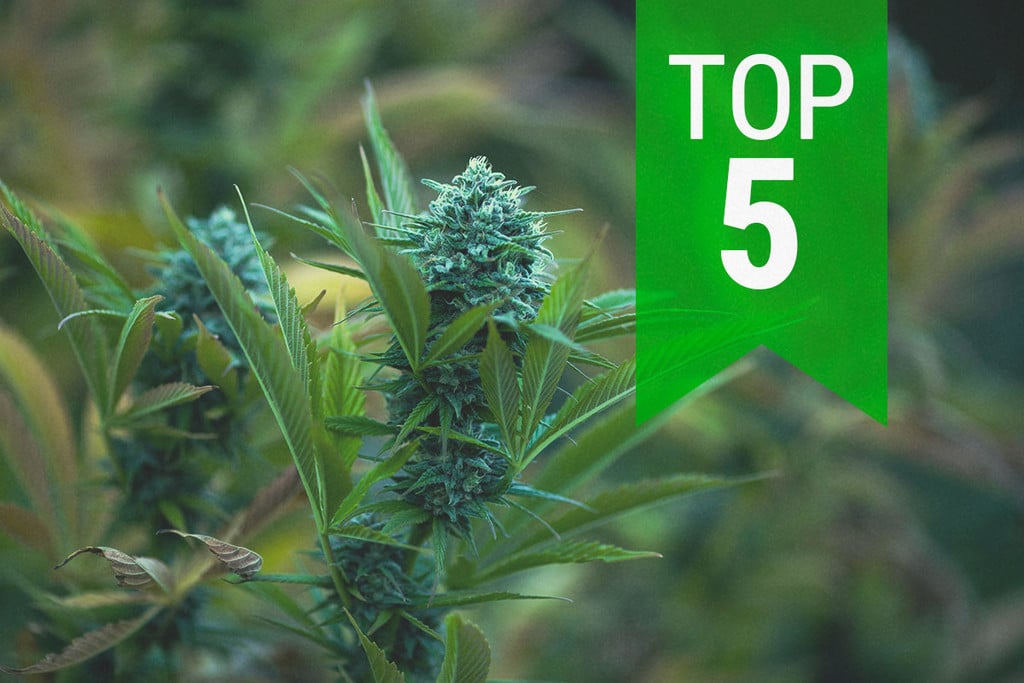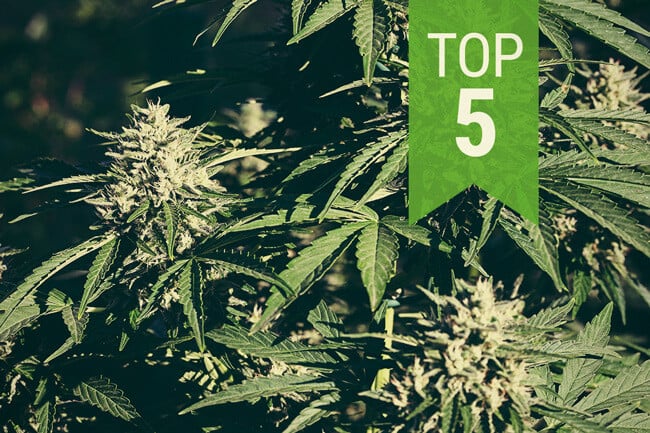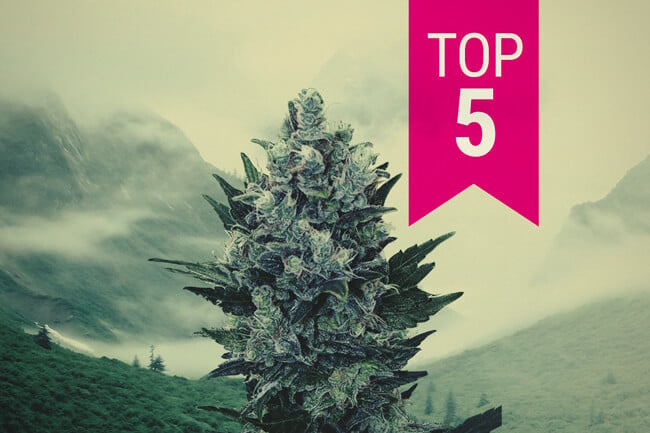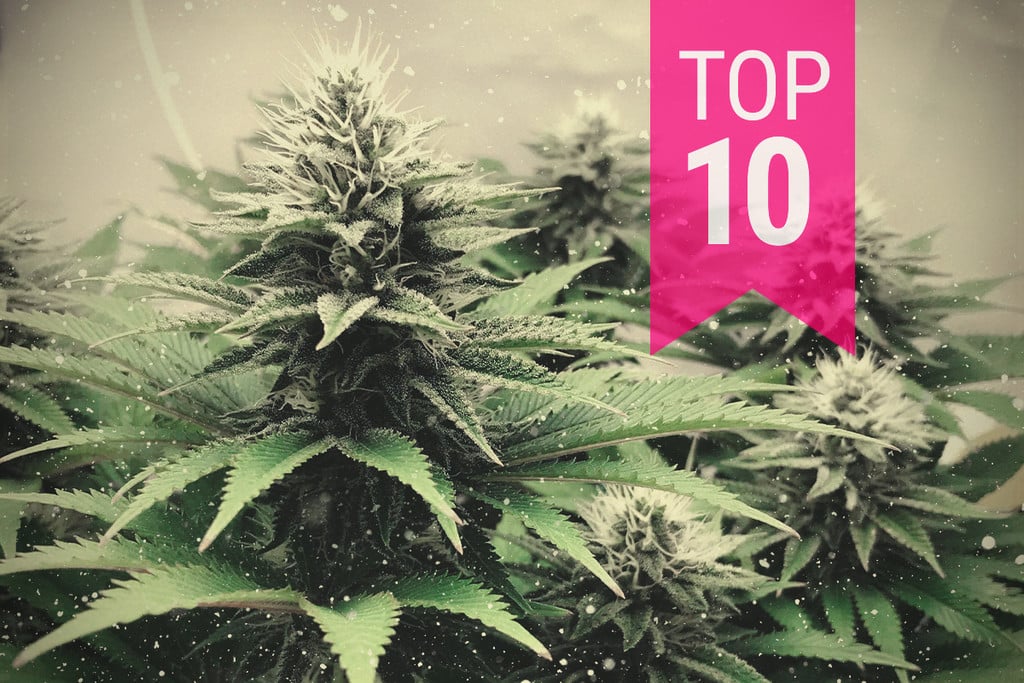.

Top Month-By-Month Tips For Growing Cannabis In Australia
Australia is a huge landmass with a number of climates. Follow these helpful month-by-month grow tips from RQS to ensure you get the best results from your cannabis plants Down Under, regardless of whether you live in the north or south.
Contents:
GROWING IN AUSTRALIA
Australia might have critters on land and in the sea that can kill you with a glance, but it also has a diverse range of climates and microclimates that are ideal for growing cannabis. The Tropic of Capricorn pretty much runs right through the middle from east to west. The northern tip of Cape York almost touches the equator at 10°, while the southernmost tip of Tasmania is close to 43° latitude and truly snows in the mountains during winter. Except for green strips that hug the coastlines and populate the forests of the island state of Tasmania, mainland Australia is mostly arid or deserts.
Growing good cannabis requires the same pampering at any latitude, only at slightly different times of the year depending on location. With a coastline full of cannabis fans that stretches for over 4,500 kilometres from north to south, pretty much every type of growing environment is represented: from the true tropics, to latitudes that have similar outdoor growing conditions to Barcelona.
The herb is still quite illegal in Australia, aside from some pilot medical marijuana programmes, yet growing and using marijuana is defiantly rife. Generally, the courts and cops consider processing cannabis crimes an embarrassing waste of time. And in the face of legal changes in Europe and America, so they should. But it only takes one grumpy judge who didn’t have their morning coffee (or spliff!) to administer a fine or a stint in jail. Be careful out there weed-loving siblings.
The averages used below are taken from Rockhampton on the Tropic of Capricorn, north to Cape York or south to Melbourne. The huge distances between each could easily be broken down further, but that is where local knowledge will need to come in. Sun and moon timetables are your best friends when planning a cannabis grow, as plants need 12 hours or more of direct sunlight per day, no matter where a grower grows.
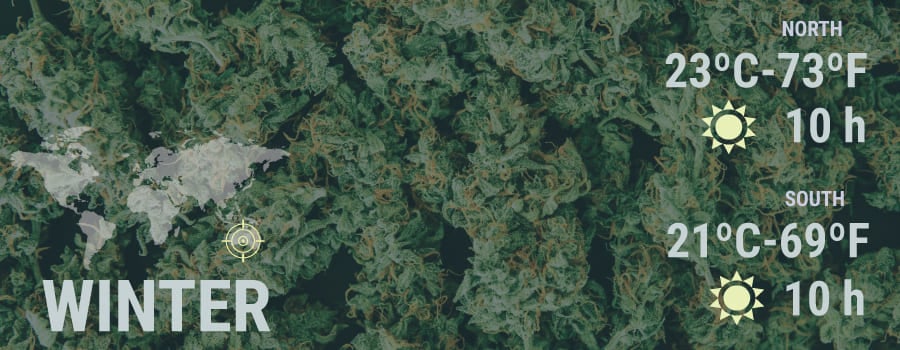
JUNE AND JULY
It’s winter in Australia, and southern outdoor growers who had a successful crop the previous year are toasting their toes by the fire and enjoying the nicely cured, resinous fruits of their labor. Their tropical northern neighbors are heaving a sigh of relief as the dry season arrives with its blessed drop in humidity. And they too are enjoying the sticky fruits of their own labors.
AUGUST
It is the last month of winter, and growers are dreaming of the coming season. Down south, there are still a few months to go before a natural planting cycle that follows the seasons. But those keen for huge, dreamy cannabis trees will be popping seeds now to put under supplemental lighting until spring, or putting clones aside to start a full vegetation prior to going outside.
Organic outdoor growers are amending pots and beds with naturally beneficial top dressings. Kelp, fish, blood and bone, shell, alfalfa, clover, and feather meals, worm castings, manures, various rock dusts, and neem cake are all of great benefit in promoting a healthy soil biology.
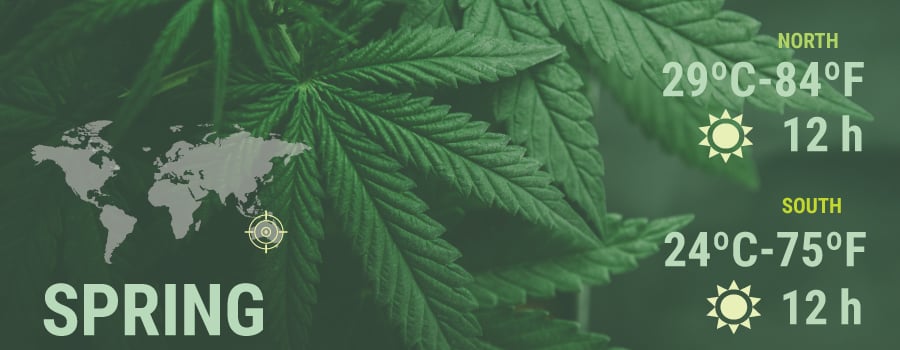
SEPTEMBER
The full moon of September is the vernal equinox—an important time for cannabis growers. Days start to lengthen beyond 12 hours, which is the minimum amount of sunlight hours required for healthy vegetative growth.
• North
AVG day length: 11:45–12:13
AVG temp: 29°C
Around the full moon is an ideal time to germinate seeds. The urges of spring produce rapid early vegetative growth in infant plants. As the weather warms and the sun intensifies, plants respond with vigorous growth, and daily increases in volume can be observed. Well-maintained soil will have enough nutrients to ensure unhindered growth until the first application of beneficial amendments.
• South
AVG day length: 11:27–12:20
AVG temp: 24°C
In general, September is still too early to guarantee proper germination and early vegetation. It is always tempting to plant early in spring, but in the south of the nation, planting this early can affect final flower production. There won’t be more than 12 hours of light until later in the month. Plants may vegetate well and look great, but the buds can end up fluffy and poorly developed. Unless the grow spot is fully exposed to sun from dawn till dusk, it is better to wait until next month to guarantee good end results.
Daylight times may be okay for a late-September germination, but temperatures are not very cannabis-friendly with winter’s chill still in the air. A greenhouse or domed seedling tray in full sun will benefit young plants while the air temperature warms up. Surprise late frosts can do some serious damage to uncovered plants at this time of year.
The first autoflower crop should be started in the north and south. As they are not reliant on photoperiod to determine growth, shorter days only mean slightly smaller plants for this first round.
OCTOBER
• North
AVG day length: 12:14–12:42
AVG temp: 31°C
Plants germinated to the urgent pulse of spring are already well-developed and have begun their long vegetation period. Climate dictates that seeds will mostly need to be sativa, and thought needs to be given to what aspect these large plants will have. Regular topping and under-shucking from an early stage (with the first top at about the 10th node), will assure plants receive maximum sun exposure and airflow. The aim is to have a canopy of flowers, while the inside is bare stalks and branches.
• South
AVG day length: 12:20–13:15
AVG temp: 26°C
Spring is in full swing now, and germinating and potting seeds for early vegetation will ensure all the efforts are worth it come harvest time. Days rapidly increase in length from here on out, providing cannabis with lots of intense sunlight while temperatures become more supportive of cannabis health and vitality.
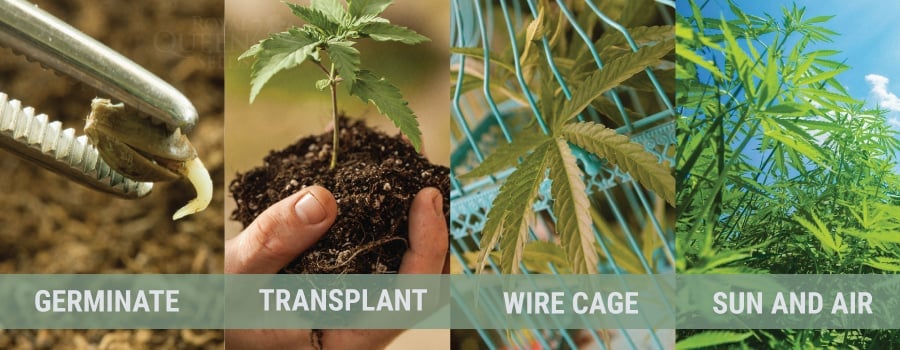
NOVEMBER
• North
AVG day length: 12:43–13:34
AVG temp: 33°C
Caging plants makes maintenance a breeze while providing ideal growing conditions for larger plants—first a small cage early in vegetation followed by another larger cage as the plant grows to keep branches well spaced. Under-shucking ensures that air circulation prevents humid conditions that may encourage pathogens.
• South
AVG day length: 13:15–13:59
AVG temp: 29°C
On both sides of the tropical line, things are pumping along now. Vegetation is in full swing and genetics are displaying themselves in leaf shape, aspect, silhouette, and growth pattern. Regular topping and pruning of large plants will stimulate verdant growth, as will tying, staking, or caging branches to open the whole plant to the sun.
Regular fortnightly spraying of natural fungicides and pesticides like neem oil will protect young plants from a number of detrimental vectors. Adding natural growth stimulants like fermented aloe and malted grain extracts, as well as beneficial fungi like Trichoderma, will reward plants in a number of ways. Aloe and malted grain add enzymes that improve soil biology and boost plant immunity; Trichoderma colonies increase all aspects of root efficiency while acting as an inoculant against soil pathogens.
Time to harvest the first and germinate the second autoflower crop.
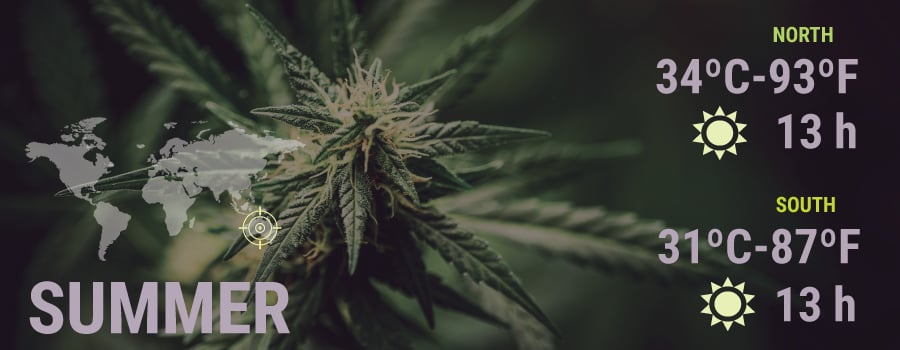
DECEMBER
• North
AVG day length: 13:34–13:39
AVG temp: 34°C
• South
AVG day length: 13:59–14:08
AVG temp: 31°C
Summer begins, and so does the Australian heat. No matter where you are, sweating in the humid tropics or baking in the dry summers of the south, it’s hot, and time to watch out for diseases in the cannabis plant.
Marijuana is a rapidly growing annual that drinks a lot of water to get as big as it can, as quick as it can. So summer provides some interesting challenges. Too much water combined with heat can create the perfect conditions for root rot and bugs like thrips and root aphids. Again, Trichoderma and other fungal and bacterial inoculant colonies can give cannabis good resistance against many root diseases and bugs. Spraying with silica when it’s hot gives a mineral boost and makes cannabis unappetising to creepy crawlies. Be sure to only spray in the cool of the evenings.
Now is a good time to add amendments to organic soils to ensure maximum soil health and nutrient availability. Meals and manures, worm castings, rock dusts, and composts all make the cannabis plant thrive. Be careful when using store-bought soil mixes as they often run very “hot” and can burn plants. Make an organic super soil and amend it regularly to maintain optimal growing conditions.
JANUARY
• North
AVG day length: 13:22–13:39
AVG temp: 34°C
• South
AVG day length: 13:36–14:08
AVG temp: 31°C
And you thought it was hot in December! The same summertime challenges still prevail. Be sure to maintain a healthy wet-dry cycle for plants. Cannabis really likes dry feet, and will be quite happy sitting in dry soil for a day or two. Watering a little at a time, but more often, avoids the possible root problems caused by drenching and having roots boil in pots. Gardens should be mulched again if the existing mulch has composted down. Using alfalfa meal as a mulch is a great way to give a regular nitrogen supply to now rapidly vegetating plants.
Foliar sprays (administered in the evenings) can help plants beat heat stress. Fermented kelp, aloe, and diluted compost teas all give plants good heat tolerance while supplementing plant growth with beneficial enzymes and amino acids.
Time to harvest the second autoflower crop and germinate the third.
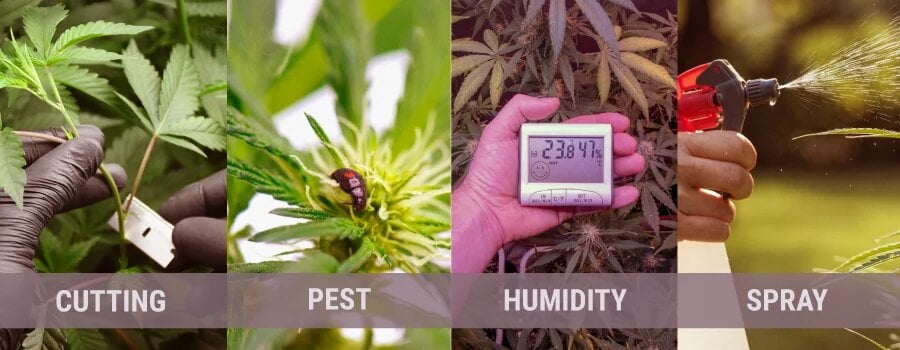
FEBRUARY
• North
AVG day length: 13:22–13:27
AVG temp: 34°C
• South
AVG day length: 12:47–13:36
AVG temp: 31°C
Strains that flower early, and many strains of feminized cannabis, will differentiate around the full moon of February. Sexual identification will be obvious in regular strains if they didn’t give hints like calyxes or bananas during late-veg.
If a lighting setup is available and you want to avoid waiting until plants sex, make clones early in the vegetation period and set them to flower once they’ve rooted. When the small plants display sex, get rid of the corresponding outdoor males while they are still vegging so that all effort goes into raising girls. Even make some more clones of known females to increase flower output at harvest.
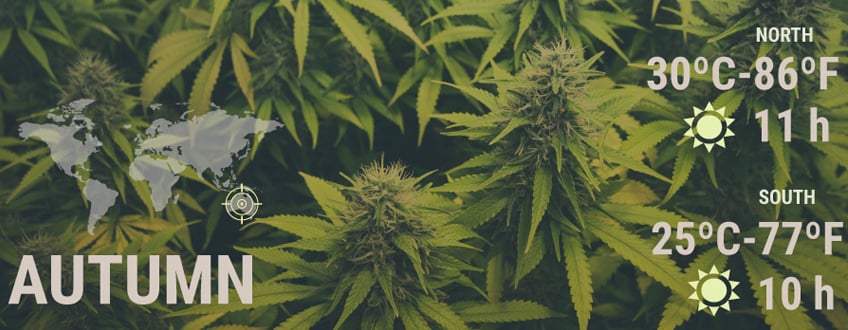
MARCH
• North
AVG day length: 11:56–13:27
AVG temp: 34°C
• South
AVG day length: 11:48–12:47
AVG temp: 30°C
Faster-flowering strains are stacking on the flowers now. Be sure to support branches as flowers get denser and heavier. Resin production is obvious as trichomes start to swell and calyxes fatten up. Aromas are developing nicely and pistils are starting to wither. Pull back on foliar spraying to ensure flavor integrity in the end product. Time to start watching trichomes for color changes.
Longer-flowering strains are differentiating and plants are now getting ready for the flower stretch. Branch tips may turn up, with internodal growth increasing to make room for flowers. From here on out, plants may double or triple in volume.
Time to harvest the third and germinate the fourth autoflower crop in the north. It is doubtful a fourth crop is possible in the south. Daylight hours decline rapidly now in the descent into fall, and winter temps will quickly become too cold for successful cannabis growth.
APRIL
• North
AVG day length: 11:30–11:55
AVG temp: 32°C
• South
AVG day length: 10:55–11:48
AVG temp: 27°C
Flowering is powering as calyxes form and stack in their own unique patterns as dictated by genetics. Indicas form tight clusters of almost indistinguishable florets while sativas have more distance between nodes and form long flower spears.
Earlier-flowering and quicker-maturing strains will be harvested from the middle of April onwards. Longer-maturing strains are at peak flowering with maximum resin production, and are entering their final phase. Telltale trichomes will announce harvest.
MAY
• North
AVG day length: 11:10–11:30
AVG temp: 29°C
• South
AVG day length: 10:16–10:55
AVG temp: 24°C
Quicker-flowering strains are dry and curing in the jar by now, and have certainly been rolled into a few spliffs or ripped through a few bongs. Probably still a little bit too much chlorophyll just yet, but still a tasty precursor to fully cured perfection. Remember, curing is important; the molecular structure of the active ingredients of weed changes as it drops moisture to become more psychotropic. Mmmmmm, more psychotropic...
Longer-flowering strains are approaching harvest all through May, so watching trichomes is as important as ever. Larger sativas will want to have the upper, more mature flowers removed early in the month to give the lower flowers more light. They will then be harvested later in the month after a few weeks unshaded.
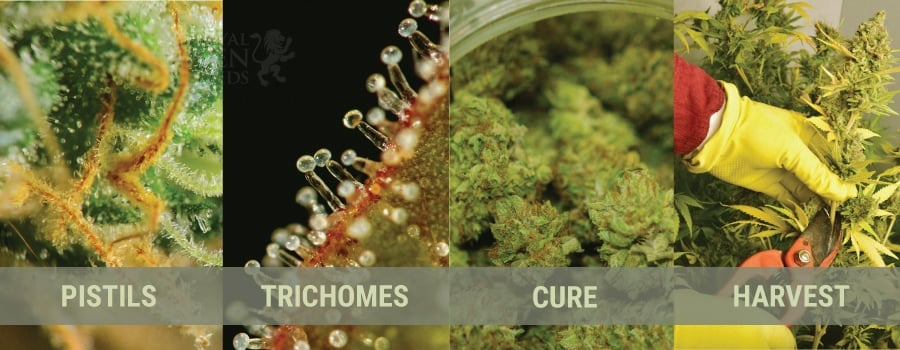
SOME NOTES ON GROWING IN THE TROPICS
For hassle-free plants that don’t revert to vegetation or simply don’t flower, strain selection is very important. Autoflowering varieties obviously sidestep issues with timing and light, and there are even some sativa specimens that mature according to an internal clock, rather than strictly by light cycle. When day lengths always hover around twelve hours, such as in the tropics, photoperiodic species like indicas, which rely on day length to trigger flowering, require light deprivation to mature properly.
Strains that are tolerant to pathogens like bud and root rot or mildew are more resilient in the wet of the tropical summer. With a solid wetting every afternoon, plants grown in the tropics need to have excellent drainage for happy roots, as well as exposure to generous sunlight to ensure evaporation of excess moisture. This is especially true at flowering time, when being too wet for too long can cause chronic bud rot, no matter how resilient the strain is.
Autoflowering varieties are a boon for tropical growers. With most strains racing, on average, from germination to harvest in three months, up to four crops per year is possible. The winter crop may not be as large as the summer crops, but there is still plenty of intense light. This certainly takes the pressure off of having to potentially do one large annual grow to get a year’s worth of weed. Moreover, a greater selection of species and strains can be grown to help keep things mixed up while you enjoy your stash throughout the year.


























